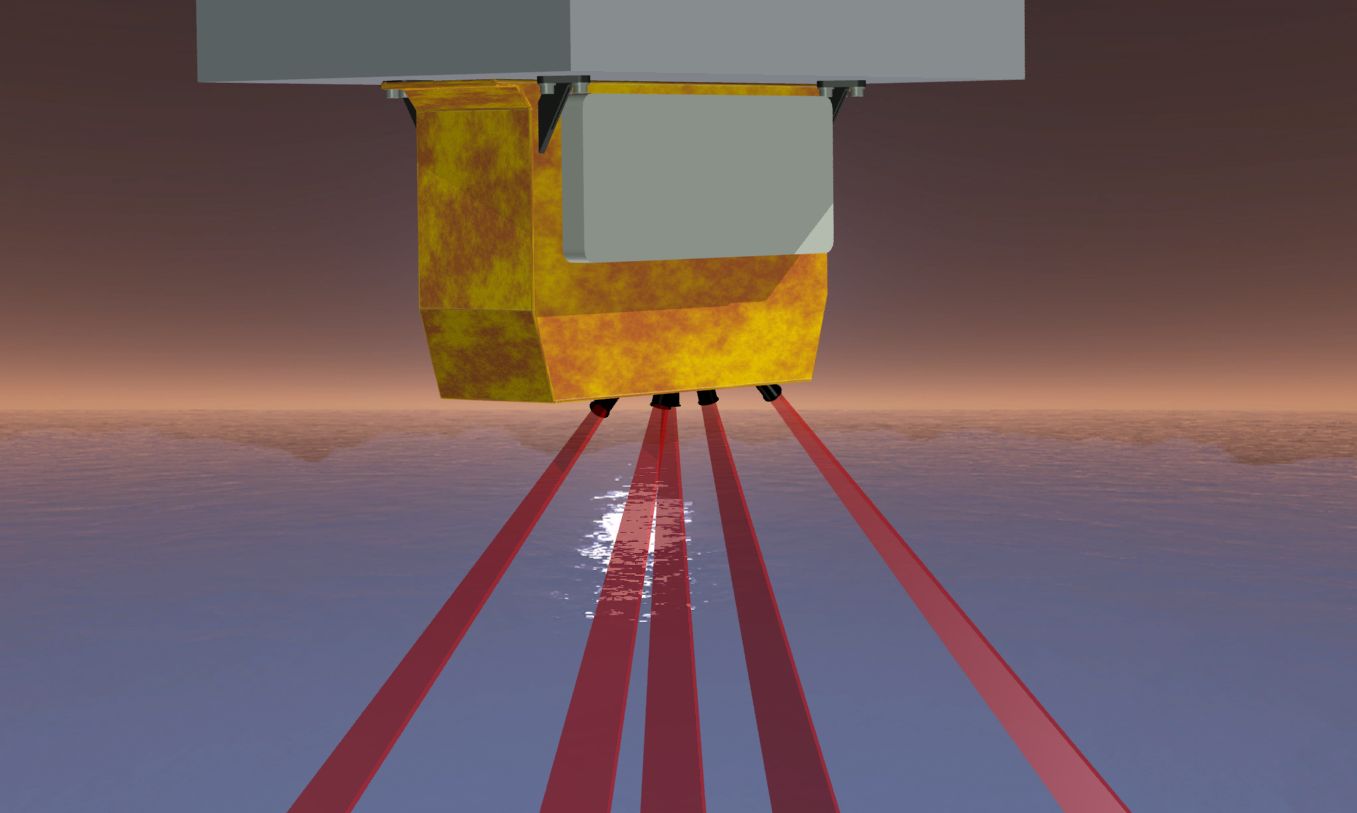Researcher Dr Otto Hasekamp from SRON Netherlands Institute for Space Research will develop a new method to determine aerosol emissions from different sources and thus better quantify the direct aerosol effect on climate. Aerosols are small dust particles in the atmosphere that influence air pollution and climate change, but their precise role remains unclear.

Dust particles influence the climate both directly and indirectly, by reflecting sunlight (direct effect) and through their influence on cloud formation (indirect effect). To determine the effect of anthropogenic (caused by humans) aerosols on the climate, a model is needed to link aerosol measurements made by satellites to the emissions of different types of aerosols. This process is called data assimilation.
Measurements
Aerosol emissions are usually estimated based on the Aerosol Optical Thickness (AOT). This is an optical measure of the quantity of dust in the entire atmospheric column above a certain part of the Earth’s surface.
Satellite instruments that perform Multi-Angle Photopolarimetric (MAP) measurements provide not just the AOT but also other information about a range of properties of the dust particles, such as absorption, size, shape, and type.
In the past, such measurements were made by the PARASOL instrument and will be made by the 3MI instrument from 2022 onwards. A new generation of improved MAP instruments is also under development, such as the Dutch SPEXOne. It is expected that the MAP measurements will greatly improve estimates of aerosol emissions.
New method
There is no method available yet that could use the accurate aerosol information provided by these MAP measurements to determine emissions of different types of aerosol. Otto Hasekamp, atmosphere researcher within the Earth Science Group of space research Institute SRON, will use financial support from the Netherlands Space Office (NSO) and the Netherlands Organisation for Scientific Research (NWO) to appoint a postdoc who will develop a method that will link the estimated aerosol emissions to the information about the particles that MAP measurements provide.
The system will be tested using simulations, and the value of various future MAP instruments for quantifying emissions will also be determined. Furthermore, the model will be used to estimate aerosol emissions based on a year of PARASOL measurements that are related to the different aerosol sources, and the direct effect of these aerosol sources on the radiation balance of the Earth will be calculated. Within the Netherlands, the research will be realized in close collaboration with VU Amsterdam and the Climate, Air & Sustainability department of TNO.
Research proposals
Hasekamp’s project ‘AEROSOURCE: Estimation of Aerosol Emissions from Polarization Data’ is one of eleven new research proposals in the area of Earth observation that has been awarded funding by NSO/NWO. The researchers involved will receive a financial boost from the program User Support Space Research (GO) that NSO realizes on behalf of the Netherlands Organisation for Scientific Research (NWO). The GO program offers financial support to researchers working in the Netherlands in order for them to be able to use the infrastructure in space for the purpose of scientific research in the area of Earth observation and planetary research.
AEROSOURCE: nieuwe methode voor bepalen aerosol-emissies
Onderzoeker dr. Otto Hasekamp van SRON Netherlands Institute for Space Research gaat een nieuwe methode ontwikkelen om aerosol-emissies van verschillende bronnen te bepalen en zo het directe aerosol-effect op het klimaat beter te kwantificeren. Aerosolen zijn kleine stofdeeltjes in de atmosfeer die luchtvervuiling en klimaatverandering beïnvloeden, maar hun precieze rol is nog niet goed bekend.

De stofdeeltjes beïnvloeden het klimaat direct en indirect, door zonlicht terug te kaatsen (direct effect) en door hun invloed op wolkenvorming (indirect effect). Om het effect van antropogene (door de mens veroorzaakte) aerosolen op het klimaat te kunnen bepalen is het belangrijk om aerosol-metingen met satellieten via een model te koppelen aan de emissies van verschillende typen aerosolen. Dat heet data-assimilatie.
Metingen
Doorgaans worden de aerosol-emissies geschat op basis van de Aerosol Optische Dikte (AOD). Dat is een optische maat voor de hoeveelheid stof in de gehele atmosferische kolom boven een deel van het aardoppervlak.
Satellietinstrumenten die zogeheten Multi-Angle Photopolarimetric (MAP)-metingen doen, geven behalve de AOD ook nog informatie over allerlei eigenschappen van de stofdeeltjes, zoals absorptie, grootte, vorm, en type.
Dergelijke metingen zijn in het verleden uitgevoerd door het PARASOL-instrument, en deze metingen zullen vanaf 2022 vervolgd worden met het 3MI-instrument. Ook is er een nieuwe generatie van verbeterde MAP-instrumenten in ontwikkeling, zoals het Nederlandse SPEXOne. MAP-metingen zullen naar verwachting de schattingen van de aerosol-uitstoot enorm verbeteren.
Nieuwe methode
Er is nog geen methode beschikbaar die gebruikmaakt van de nauwkeurige aerosol-informatie die MAP-metingen bieden om emissies van verschillende aerosol-types te bepalen. Otto Hasekamp, als atmosfeeronderzoeker werkzaam binnen de Earth Science Group van ruimteonderzoeksinstituut SRON, gaat nu met financiële steun van het Netherlands Space Office (NSO) en de Nederlandse organisatie voor Wetenschappelijk Onderzoek (NWO) een postdoc aanstellen om een methode te ontwikkelen die de geschatte aerosol-emissies koppelt aan de informatie over de deeltjes die MAP-metingen leveren.
Door middel van simulaties zal het systeem getest worden en zal ook de waarde van verschillende toekomstige MAP-instrumenten voor het kwantificeren van emissies bepaald worden. Bovendien zal het model worden gebruikt om aerosol-emissies te schatten op basis van een jaar aan PARASOL-metingen die worden gerelateerd aan de verschillende aerosol-bronnen, en zal het directe effect van deze aerosol-bronnen op de stralingsbalans van de aarde berekend worden. Binnen Nederland zal nauw samengewerkt worden met de Vrije Universiteit in Amsterdam en de TNO-afdeling Climate, Air & Sustainability.
Onderzoeksvoorstellen
Hasekamps project ‘AEROSOURCE: Estimation of Aerosol Emissions from Polarization Data’ is een van de elf nieuwe onderzoeksvoorstellen op het gebied van aardobservatie die gehonoreerd zijn door NSO/NWO. De betrokken onderzoekers krijgen een financiële injectie vanuit het programma Gebruikersondersteuning Ruimteonderzoek (GO) dat het NSO uitvoert in opdracht van de Nederlandse Organisatie voor Wetenschappelijk Onderzoek (NWO). Het GO-programma biedt financiële ondersteuning aan in Nederland werkzame onderzoekers bij het gebruik van infrastructuur in de ruimte ten behoeve van wetenschappelijk onderzoek op het gebied van aardobservatie en planeetonderzoek.


